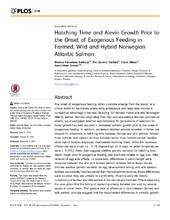Hatching time and alevin growth prior to the onset of exogenous feeding in farmed, wild and hybrid Norwegian Atlantic salmon
| dc.contributor.author | Solberg, Monica Favnebøe | |
| dc.contributor.author | Fjelldal, Per Gunnar | |
| dc.contributor.author | Nilsen, Frank | |
| dc.contributor.author | Glover, Kevin | |
| dc.date.accessioned | 2016-04-08T13:14:06Z | |
| dc.date.available | 2016-04-08T13:14:06Z | |
| dc.date.issued | 2014-12-01 | |
| dc.Published | 2014, 9(12:) | eng |
| dc.identifier.issn | 1932-6203 | en_US |
| dc.identifier.uri | http://hdl.handle.net/1956/11871 | |
| dc.description.abstract | The onset of exogenous feeding, when juveniles emerge from the gravel, is a critical event for salmonids where early emergence and large size provide a competitive advantage in the wild. Studying 131 farmed, hybrid and wild Norwegian Atlantic salmon families, originating from four wild populations and two commercial strains, we investigated whether approximately 10 generations of selection for faster growth has also resulted in increased somatic growth prior to the onset of exogenous feeding. In addition, we tested whether relaxed selection in farms has allowed for alterations in hatching time between farmed and wild salmon. Across three cohorts, wild salmon families hatched earlier than farmed salmon families, while hybrid families displayed intermediate hatching times. While the observed differences were small, i.e., 1–15 degree-days (0–3 days, as water temperatures were c. 5–6°C), these data suggest additive genetic variation for hatching time. Alevin length prior to exogenous feeding was positively related to egg size. After removal of egg size effects, no systematic differences in alevin length were observed between the wild and farmed salmon families. While these results indicate additive genetic variation for egg development timing, and wild salmon families consistently hatched earlier than farmed salmon families, these differences were so small they are unlikely to significantly influence early life history competition of farmed and wild salmon in the natural environment. This is especially the case given that the timing of spawning among females can vary by several weeks in some rivers. The general lack of difference in size between farmed and wild alevins, strongly suggest that the documented differences in somatic growth rate between wild and farmed Norwegian Atlantic salmon under hatchery conditions are first detectable after the onset of exogenous feeding. | en_US |
| dc.language.iso | eng | eng |
| dc.publisher | Public Library of Science | en_US |
| dc.rights | This is an open-access article distributed under the terms of the Creative Commons Attribution License, which permits unrestricted use, distribution, and reproduction in any medium, provided the original author and source are credited. | eng |
| dc.rights.uri | http://creativecommons.org/licenses/by/4.0/ | eng |
| dc.title | Hatching time and alevin growth prior to the onset of exogenous feeding in farmed, wild and hybrid Norwegian Atlantic salmon | en_US |
| dc.type | Peer reviewed | |
| dc.type | Journal article | |
| dc.date.updated | 2015-03-03T15:27:33Z | en_US |
| dc.description.version | publishedVersion | en_US |
| dc.rights.holder | Copyright: 2014 Solberg et al. | en_US |
| dc.source.articlenumber | e0118419 | |
| dc.identifier.doi | https://doi.org/10.1371/journal.pone.0113697 | |
| dc.identifier.cristin | 1210238 | |
| dc.source.journal | PLoS One | |
| dc.source.40 | 9 | |
| dc.source.14 | 12 | |
| dc.subject.nsi | VDP::Mathematics and natural scienses: 400::Basic biosciences: 470::Genetics and genomics: 474 | en_US |
| dc.subject.nsi | VDP::Matematikk og naturvitenskap: 400::Basale biofag: 470::Genetikk og genomikk: 474 | en_US |
| dc.subject.nsi | VDP::Matematikk og Naturvitenskap: 400::Zoologiske og botaniske fag: 480::Marinbiologi: 497 | en_US |
Tilhørende fil(er)
Denne innførselen finnes i følgende samling(er)
Med mindre annet er angitt, så er denne innførselen lisensiert som This is an open-access article distributed under the terms of the Creative Commons Attribution License, which permits unrestricted use, distribution, and reproduction in any medium, provided the original author and source are credited.

